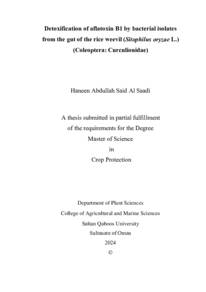وثيقة
Detoxification of aflatoxin B1 by bacterial isolates from the gut of the rice weevil (Sitophilus oryzae L.) (Coleoptera: Curculionidae).
المصدر
Master's thesis
عناوين أخرى
إزالة السموم من الأفلاتوكسين ب1 بواسطة العزلات البكتيرية من أمعاء سوسة الأرز) (L.Sitophilus oryzae ) عمدية الأجنحة Curculionidae: Coleoptera).
الدولة
Oman
مكان النشر
Muscat
الناشر
Sultan Qaboos University.
ميلادي
2024
اللغة
الأنجليزية
نوع الرسالة الجامعية
Master's thesis
الملخص الإنجليزي
Aflatoxin contamination in food products is a serious global concern due to its well documented carcinogenic, mutagenic and immunosuppressive effects on human health. The aflatoxins are primarily produced by Aspergillus flavus and A. parasiticus as secondary metabolites when they grow on agricultural commodities such as maize, groundnut, chilli, tree nuts and rice. Among the various types of aflatoxins, aflatoxin B1 (AFB1) poses the greatest threat to humans. People are exposed to aflatoxin directly by ingesting contaminated food or indirectly through animal-source foods such as milk, eggs, and meat derived from animals previously exposed to aflatoxins in their feed. Eradicating or removing aflatoxin after its formation in an agricultural commodity is challenging due to its high stability. To minimize the harmful effects of aflatoxin, a variety of detoxification procedures are employed. The use of microorganisms is considered a practical biological approach to reduce aflatoxin levels in foods and feeds. The microorganisms achieve this reduction through either physical binding or enzymatic degradation of aflatoxin. In general, the insects feeding on AFB1-contaminated cereal grains are unaffected. It was hypothesized that bacteria residing in the gut of such insects may possess the capacity to degrade/bind aflatoxin and reduce its toxic effects. In this study, bacteria residing in the gut of the rice weevils (Sitophilus oryzae L.) (Coleoptera: Curculionidae) feeding on aflatoxin-contaminated corn kernels were isolated and evaluated for their ability to suppress Aspergillus flavus and to remove/degrade AFB1. Four morphologically distinct S. oryzae gut-associated bacterial isolates were isolated and identified as Bacillus subtilis (RWGB1), Bacillus oceanisediminis (RWGB2), Bacillus firmus (RWGB3) and Pseudomonas aeruginosa (RWGB4) based on 16S rRNA gene sequence analysis. These bacterial isolates inhibited A. flavus growth in the dual culture assay and induced morphological deformities in the fungal hyphae, as confirmed by scanning electron microscopy. All four bacterial isolates were capable of removing AFB1 from the nutrient broth medium. In addition, culture supernatants of these bacterial isolates degraded AFB1, and the degradation of toxin molecule was confirmed by liquid chromatography-mass spectrometry. The bacterial isolates, B. subtilis RWGB1, B. oceanisediminis RWGB2 and P. aeruginosa RWGB4, were capable of producing antifungal volatile organic compounds that inhibited A. flavus growth. These results suggest that the bacterial isolates from S. oryzae gut have the potential to bind and/or degrade AFB1. Further research on their application in the food and feed industries could enhance the safety of food and feed production.
الملخص العربي
التلوث بالأفلاتوكسين في المنتجات الغذائية مصدر قلق عالمي خطير بسبب أثاره الموثقة جيداً على صحة الإنسان سواء منها المسرطنة أو المطفرة للجينات أو المثبطة للمناعة ينتج الأفلاتوكسين في المقام الأول عن طريق فطري Aspergillus flavus و A parasiticus ، كمنتجات أيضية ثانوية عندما ينمو هذان القطران على المنتجات الزراعية مثل الدرة والفول السوداني والفلفل الحار والمكسرات والأرز من بين الأنواع المختلفة للأفلاتوكسين يشكل الأفلاتوكسين ب (AFB1) أكبر خطر على الإنسان ويتعرض الناس للأفلاتوكسين بشكل مباشر عن طريق تناول الأغذية الملوثة أو بشكل غير مباشر من خلال الأغنية ذات المصدر الحيواني مثل الحليب والبيض واللحوم المشتقة من الحيوانات التي سبق أن تعرضت للأفلاتوكسين في علقها ويشكل القضاء على الأفلاتوكسين أو إزالته بعد تكوينه في المنتج الزراعي تحديا بسبب ثباته العالي والتقليل من الآثار الصارة للأفلاتوكسين، يتم استخدام مجموعة متنوعة من طرق إزالة السمية يعتبر استخدام الكائنات الحية الدقيقة نهجا بيولوجياً عمليا لتقليل مستويات الأفلاتوكسين في الأغدية والأعلاف وتحقق الكائنات الدقيقة هذا الحفص إما من خلال التقييد الفيزيائي أو التحليل الأنريمي للأفلاتوكسين بصفة عامة، لا تتأثر الحشرات التي تتغدى على الحبوب الملوثة بالأفلاتوكسين AFB1. لقد افترضنا أن البكتيريا المقيمة في أمعاء هذه الحشرات تمتلك القدرة على تحليل تقييد الأفلاتوكسين وتقليل أثاره السامة في هذه الدراسة، تم عزل البكتيريا التي تعيش في أمعاء سوسة الأور ( Sitophilus oryzae L) (عمدية الأجنحة Curculionidae Coleoptera) التي تتعدى على حبوب الدرة الملوثة بالأفلاتوكسين وتقييم قدرتها على تشبيط قطر Aspergillus flavus وإزالة بتحليل مادة AFB1 تم عزل أربع عزلات بكتيرية متميرة شكليا من بكتيريا Bacillus Bacillus subtilis (RWGB1( وتم تعريفها على أنها ،S oryzae مرتبطة بأمعاء Pseudomonas aeruginosa (RWGB3) Bacillus firmus 3 (RWGB2) oceanisediminis (RWCB4) ، استناداً إلى تحليل تسلسل الجين 1 وقد تبطت هذه العزلات البكتيرية نمو قطر 4 flaves في اختبار الاستزراع المردوج، وتسببت في حدوث تشوهات شكلية في الخيوط الفطرية، بتأكيد الفحص المجهري الإلكتروني كانت جميع العزلات البكتيرية الأربعة قادرة على إزالة مادة AFBI من المستنبت البكتيري السائل وبالإضافة إلى ذلك، حللت المواد الطاقية الناتجة من استزراع العازلات البكتيرية مادة AFBI، وتم تأكيد تحلل جزيء السم بواسطة جهاز التحليل اللوني السائل - مطياف الكتلة كانت العزلات البكتيرية، B. subtilis قادرة على إنتاج مركبات Paeruginosa RWGB4 و RWGB2 B. oceanisediminis RWGBI عضوية متطايرة مضادة للفطريات مثبطة لنمو قطر A Davus تشير هذه النتائج إلى أن العزلات البكتيرية من المعاء ب onzae لديها القدرة على تقييد و أو تحليل مادة AFBI إن الأبحاث المستقبلية على تطبيق هذه العملات في صناعات مواد الأغذية والأعلاف متعرر سلامة إنتاج هذه المواد.
قالب العنصر
الرسائل والأطروحات الجامعية

